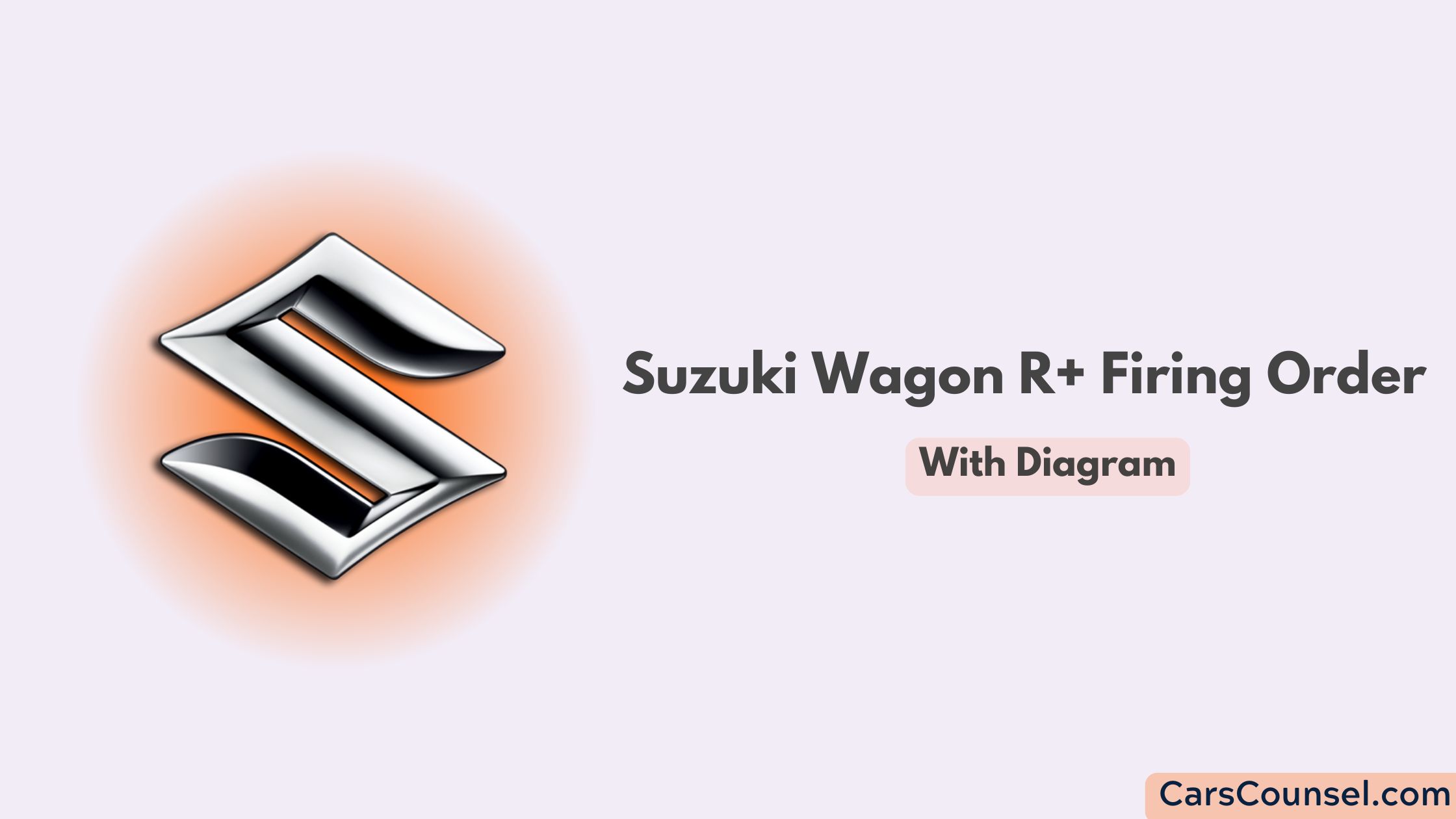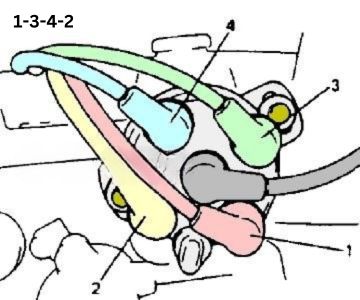The Suzuki Wagon R+, known for its compact design, reliability, and practicality, has been a popular choice among small car enthusiasts.
The firing order is central to the smooth operation of its engine—a crucial detail that ensures the engine runs efficiently and reliably.
If you’re an owner, mechanic, or enthusiast, understanding the firing order of the Suzuki Wagon R+ is essential for maintenance and troubleshooting. In this guide, we’ll dive into the specifics of the Wagon R+ firing order, its importance, and how to ensure it’s functioning properly.

Quick Navigation
What is the Firing Order of Suzuki Wagon R+?
For most Suzuki Wagon R+ engines, particularly the inline-four-cylinder models, the firing order is 1-3-4-2. Each number corresponds to a cylinder, and this sequence repeats in cycles as the engine operates.

The firing order refers to the sequence in which the engine’s cylinders ignite their air-fuel mixture.
This ignition process drives the pistons, rotates the crankshaft, and produces the power needed to move the vehicle. In a well-tuned engine, the firing order ensures that the combustion process is smooth, balanced, and efficient.
Why is the Firing Order Important?
The firing order is a cornerstone of engine performance. Here’s why it matters:
Smooth Engine Operation
A balanced firing order prevents unnecessary vibrations, ensuring the engine runs quietly and smoothly.
Efficient Power Delivery
By spacing the power strokes evenly, the firing order optimizes the rotation of the crankshaft, delivering consistent power.
Reduced Component Wear
Proper timing minimizes stress on internal components like the crankshaft and bearings, extending their lifespan.
Improved Fuel Efficiency
A correct firing sequence ensures complete combustion, reducing fuel wastage.
Prevention of Engine Misfires
The right firing order eliminates irregularities in the combustion process, preventing misfires and other performance issues.
The Engine Layout of the Suzuki Wagon R+
To understand the firing order, it’s important to first familiarize yourself with the layout of the Suzuki Wagon R+ engine. Most Wagon R+ models feature an inline-four engine, where all four cylinders are arranged in a single straight line.
Cylinder Numbering
In the Suzuki Wagon R+ inline-four engine:
- Cylinder 1: Closest to the timing belt or accessory drive.
- Cylinder 4: Farthest from the timing belt, near the flywheel
The numbering follows a sequential order, making it easier to identify and work on specific cylinders during maintenance.
The Firing Order: 1-3-4-2
The 1-3-4-2 firing order is standard for most inline-four engines, including those in the Suzuki Wagon R+. This sequence alternates between cylinders to ensure balanced power delivery and smooth operation.
How It Works:
- Cylinder 1 Fires First: Located closest to the timing belt, cylinder 1 initiates the power cycle.
- Cylinder 3 Fires Next: The sequence moves to cylinder 3, positioned in the middle of the engine.
- Cylinder 4 Fires Third: The firing process shifts to cylinder 4, furthest from the timing belt.
- Cylinder 2 Fires Last: Finally, cylinder 2 fires, completing the cycle before it repeats.
This alternating pattern prevents imbalances and ensures the crankshaft rotates evenly.
Components That Support the Firing Order
Several key components work together to execute the firing order in the Suzuki Wagon R+:
Crankshaft
Converts the pistons’ up-and-down motion into rotational energy, aligned with the firing sequence.
Camshaft
Controls the opening and closing of intake and exhaust valves, ensuring proper timing for each cylinder.
Distributor or Ignition Coil
Directs electrical current to the spark plugs in the correct firing order. Many modern Suzuki engines use ignition coils rather than distributors.
Spark Plugs
Ignite the air-fuel mixture in each cylinder, generating the power needed to move the pistons.
Engine Control Unit (ECU)
The ECU manages the ignition timing and firing sequence, ensuring the firing order is executed precisely.
Symptoms of Firing Order Problems
If the firing order is disrupted or incorrect, the engine will exhibit noticeable symptoms. Recognizing these signs early can prevent further damage:
Engine Misfires
An incorrect firing order can cause one or more cylinders to misfire, leading to rough engine operation.
Rough Idling
The engine may idle unevenly, causing vibrations or even stalling.
Loss of Power
A disrupted firing order reduces the engine’s efficiency, leading to sluggish performance.
Knocking or Backfiring
Incorrect timing may cause premature combustion, resulting in knocking noises or backfires.
Increased Fuel Consumption
An imbalanced engine burns more fuel to compensate for firing irregularities.
Diagnosing and Correcting Firing Order Issues
If you suspect a problem with the firing order in your Suzuki Wagon R+, follow these steps to diagnose and correct it:
Step 1: Inspect the Ignition System
- Check the spark plugs for wear or fouling. Replace them if necessary.
- Ensure the ignition wires are properly connected to the correct cylinders according to the 1-3-4-2 firing order.
Step 2: Check the Timing
- Use a timing light to verify the ignition timing. Adjust the timing if it’s out of alignment.
Step 3: Test the Ignition Coil or Distributor
- For models with a distributor, inspect the cap and rotor for damage. For models with ignition coils, test the coils for proper functionality.
Step 4: Consult the Service Manual
- Refer to the Suzuki service manual for detailed diagrams and specifications related to the engine’s firing order and ignition system.
Step 5: Start the Engine and Test
- Once adjustments are made, start the engine and monitor its performance. Look for smooth idling, consistent power delivery, and reduced fuel consumption.
Maintenance Tips to Preserve the Firing Order
To ensure the firing order remains intact and the engine operates smoothly, regular maintenance is key. Here are some tips:
Replace Spark Plugs on Schedule
Worn spark plugs can disrupt the ignition process. Follow the manufacturer’s recommendations for replacement intervals.
Inspect Ignition Wires Regularly
Look for signs of wear, cracking, or loose connections. Replace damaged wires immediately.
Service the Ignition Coil or Distributor
Clean and inspect the ignition coil or distributor components during routine maintenance.
Check Engine Timing Periodically
Use a timing light to verify the engine’s timing and ensure it aligns with the firing order.
Keep the Fuel System Clean
Maintain the fuel injectors and fuel lines to support efficient combustion in each cylinder.
Common Misconceptions About Firing Order
“All Inline-Four Engines Have the Same Firing Order”
While 1-3-4-2 is common, some inline-four engines use different firing orders depending on their design.
“The Firing Order Can Be Adjusted for Performance”
Changing the firing order without redesigning the engine can cause significant damage and reduce efficiency.
“Firing Order Doesn’t Impact Fuel Efficiency”
An incorrect firing order disrupts combustion, leading to increased fuel consumption and lower efficiency.
Conclusion
The firing order of the Suzuki Wagon R+, 1-3-4-2, is a critical aspect of its engine’s operation. By understanding this sequence and maintaining the components that support it, you can ensure your engine runs smoothly, efficiently, and reliably. Whether you’re performing routine maintenance or troubleshooting a performance issue, knowledge of the firing order is invaluable.
With regular care and attention, your Suzuki Wagon R+ will continue to deliver the dependable performance and fuel efficiency it’s known for. Whether you’re a seasoned mechanic or a curious owner, mastering the firing order is a key step in appreciating and maintaining this versatile vehicle.

